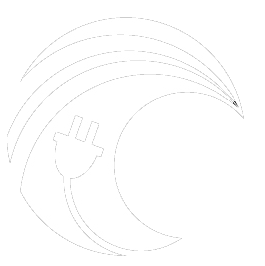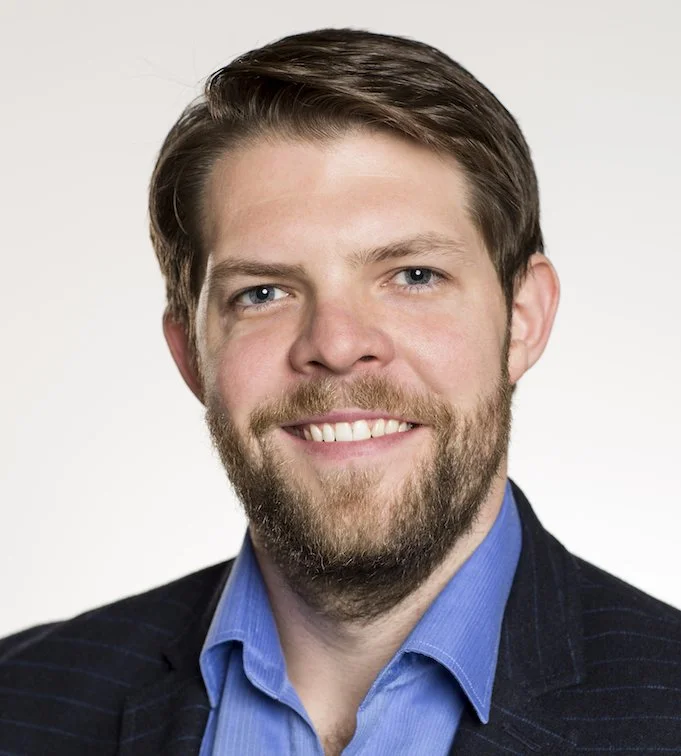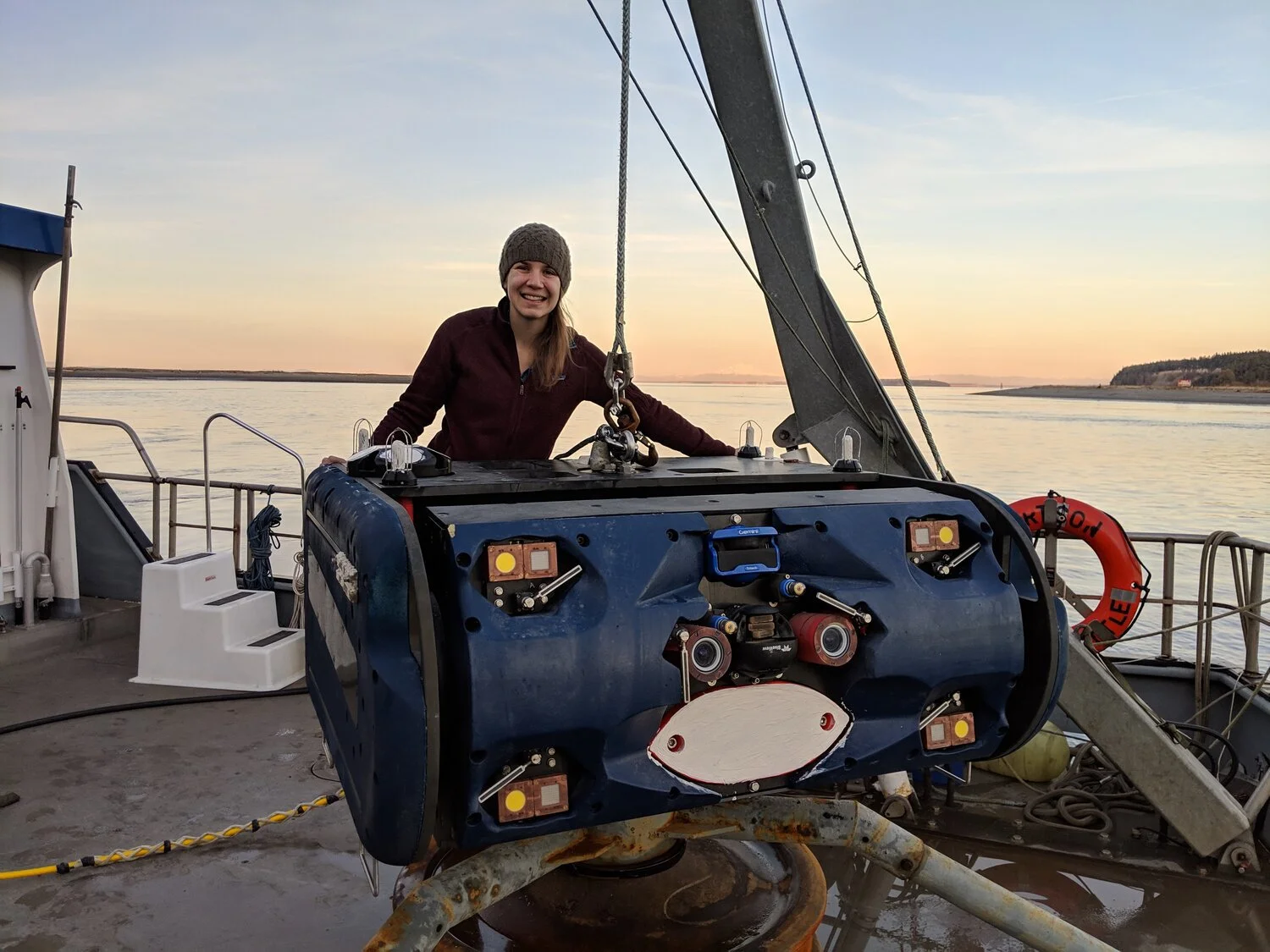This fall PMEC welcomes two new associate directors to the leadership team: Emma Cotter (left) and Owen Williams (right). Cotter is a PMEC alum and a Research Engineer in the Coastal Sciences Division at Pacific Northwest National Laboratory with a joint appointment in the Department of Mechanical Engineering at the University of Washington. Williams is an Associate Research Professor in the Department of Aeronautics and Astronautics at the University of Washington.
PMEC’s outgoing associate directors, Shana Hirsch and Michelle DiBenedetto, made many invaluable contributions to the PMEC community and collaboratively charted our research center through a phase of significant growth.
PMEC’s communications and programs manager, Judy Twedt, sat down for an online conversation with Cotter and Williams to learn about their backgrounds, history with marine energy, and interests as PMEC leaders.
These conversations have been edited for clarity.
Emma Cotter
Cotter stands behind the Adaptable Monitoring Package (AMP) before deployment in Sequim Bay.
What inspired your interests in marine energy?
In my middle school there was an all-girls robotics program. There were probably 40 students in it, it was a really big group. It was a cool environment at such a young age to be able to explore engineering. While at the moment, as a 12 year old, I wasn’t putting it all together, I think that helped me start thinking about the world in a certain way.
Later, I decided to do a PhD in mechanical engineering related to energy and the environment, and while exploring my options for grad school I realized that all the projects that excited me most were related to the development of environmental sensing systems. I talked with Brian Polagye and ended up working on a project developing an integrated sensor system for environmental monitoring at marine renewable energy sites - the Adaptable Monitoring Package. I didn’t know anything about marine energy at the time, but I’m so happy that I ended up in this field.
Now, most of my research relates to environmental monitoring of offshore renewable energy systems. My work focuses on developing the tools and methods to understand how anthropogenic activities in the ocean interact with the environment.
I had a full-circle moment a couple years ago when Pacific Northwest National Laboratory purchased an Adaptable Monitoring Package from MarineSitu (a spin-off company from UW that is commercializing the technology). It was really neat to see this becoming a product and maturing as a technology.
What excites you about marine energy right now?
The broad range of research questions and technical expertise that's needed. It's really neat getting to work in a field with so much overlap between social, environmental, and engineering fields. I love collaborating with people working on different parts of the problem.
Tell me about your relationship with PMEC.
I’ve been involved with PMEC for more than 10 years now, first as a grad student from 2014 - 2019. I left the marine energy space for a couple years as a post doc, then was involved again when I joined the staff at Pacific Northwest National Laboratory (PNNL). Through my joint appointment in the Mechanical Engineering Department at the University of Washington, I’ve had different ways of collaborating with folks in PMEC, and stayed involved through the last few years.
How did PMEC influence you as a graduate student?
It was a great community! As a PhD student, you become very narrowly focused, but through PMEC I was able to build broad connections and learn about all the other aspects of the bigger [marine energy] picture. I’ve stayed connected to and relied upon my PMEC network from graduate school.
To someone interested in a career in marine energy, what's the first thing you would tell them about PMEC?
If you’re looking to be on the R&D side of marine energy, there are great opportunities in PMEC to dig into all aspects (social, engineering, environmental). If you want to build a career in marine energy, having an understanding of the different sides of the field outside of your domain is going to make you a more well rounded contributor.
What are you hoping to improve or build upon, as an associate director?
I know there are a lot of PMEC alums at national labs. I am interested in developing alumni relationships and providing support for students interested in careers in national labs in marine energy or adjacent spaces and thinking about how to foster those relationships.
Owen Williams
Williams in his turbulence laboratory at the University of Washington’s Department of Aeronautics and Astronautics.
What inspired your interests in marine energy?
My background is in aerodynamics and hydrodynamics. I was always interested in vehicles and things that fly. I also grew up in Ontario, and love being on the water. [This field] helps me blend my interest in being on and around the water with my background in conventional aircraft and vehicles. Renewable energy presents a lot of really big challenges from an aerodynamics perspective: moving, unsteady flows and a lot of unforgiving environments. It’s a fun way to bring it all together, and have a positive impact.
Also, my wife is an oceanographer, and she’s taught me a lot about the ocean.
What were some of the earliest projects that merged your background in aerodynamics with marine energy?
I work with wind and water tunnels – lab scale. As a result of this background I have a lot of expertise working with the diagnostics that help us understand what’s really going on [in the flow field] in great detail. If you can measure a flow more accurately, then you can understand why a turbine or vehicle behaves the way it does and then hopefully head in the right direction when optimizing the system. Otherwise there are too many different parameters and you’re taking a stab in the dark. So I partnered with Brian Polagye, looking at tidal power and estuarine systems when I started at UW. This allowed me to expand my knowledge in the marine energy sector.
What research are you excited about right now?
I’m really excited about the work conducted by my student Ari Athair. His interest has been the shape of the foils we use in [tidal] turbines. Traditionally, because cross-flow turbines rotate, the flow greatly changes direction around the cycle. As a result, everyone thought, ‘let's start with a foil that is symmetric, we don’t see a reason to do much else,’ but our understanding has evolved. We now understand that as the blade goes around a curve, the blade is effectively curved as well, in a virtual sense, and that curvature ties into what the optimal pitch and shape should be. Ari has done a whole bunch of experiments looking at how we optimize the shape of these blades to either get higher power or smooth out the loading on the turbine, something which could have structural or power quality benefits. He’s just publishing all those papers right now. [Editors note – Ari presented this research at EWTEC in September, you can find a link to his presentation here].
Tell me about your relationship with PMEC.
I’ve been involved with a lot of different programs and pieces of programs with PMEC researchers at UW, lending my expertise on a diagnostic side. Our recent work exploring the impact of turbulence and eddies on turbine power production brings me back into my traditional background in aerodynamics.
I’ve also been going to PMEC meetings for years, participated in TEAMER programs, participated in the ARPA-E SHARKS program, and have always wanted to be more involved. It’s a great network.
To someone interested in a career in marine energy, what's the first thing you would tell them about PMEC?
There’s so many different ways to be connected. Most of the other groups I’m involved with are primarily engineers, but when I go to PMEC meetings, we’ve got people whose role is to develop local community relationships, or environmental impacts and monitoring. There are people out there looking at resources or people developing the engineering behind the energy devices. So many different ways to be involved regardless of your background. These people are very passionate and come from many different directions.
What are you hoping to improve or build upon, as an associate director?
Bringing people together to cross pollinate ideas between different institutions and labs is one of the biggest areas I want to contribute to; also advocating for marine energy from lab to production, and in general to help maintain the good PMEC community. It has been a really good community, and the more we can foster connections between the universities and with industry, the better.




